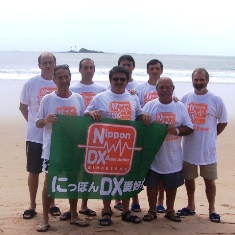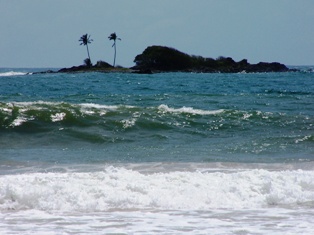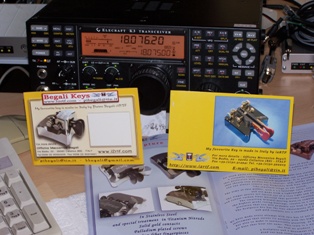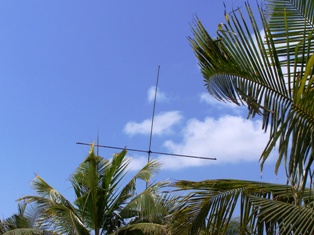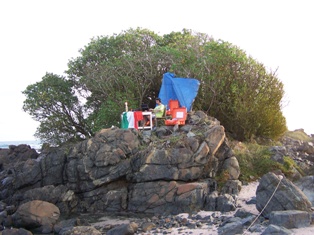Ghana 9G5TT
9G5TT 9G5XX Ghana Abokwa Is. AF084
We started some years ago to visit rare or semi rare countries looking for as many qso as possible to give to the radio hams from there.
After having been to Africa several times in the last years, latest to Sierra Leone on October 2008, we were thinking of changing the target and moving somewhere to the Pacific Ocean. Unfortunately, due to an unusually lazy sun, the spots are still low and a poor propagation on the high bands does not encourage to afford a long and costly trip just to put a few thousand qso in the log. Again we froze our ambition and we focused our attention on a nearer country, not far from Europe and USA, maybe not so rare to be on top of the most wanted but rare enough to have fun. Of course the dream book is still open on some peculiar pages but the countries where we dream to go remain still inaccessible.
It is true, anyhow, that even if a country is not in the top rank, it may grant a lot of fun going there as a well organized dx expedition can cover the activity on all the bands and there are thousands of hams, old and new comers, who are happy to put in the log the country in many bands and modes which is not possible to achieve in another way.We experienced it from Djibouti and Sierra Leone, being the number of qso and unique calls much higher than what expected. And if it is possible to couple the activity from a country which is also an IOTA reference the interest will be surprisingly high in the ham community. Based on that, when Stefano IK2HKT found Abokwa Is. AF-Ø84 in Ghana, we immediately approved the project to go there. The island itself, 350 km approx west of Accra, is too small to guest people, it is just a rock 100m long and 20m large and it may be reached even by swimming as it just 1 km far from the main land. It is absolutely inhospitable, just rocks, two palms and some shrubs.Impossible, therefore, to plan our activity from there. But Stefano finally discovered a nice resort just in front of the island which we decided to elect as our base for the major activity, planning to go to the island temporarily.Those who are used to have contact with Africa and its people and with the local bureaucracy know what it means to apply for a radio ham licence. What would be possible to get in few days needs weeks and months there, dozens of telephone calls and mails. And finally after bothering some Italians in Ghana to go personally to the PT ministry, our licenses were issued, one per each operator. We were not taken by surprise when we discovered two of the callsigns were wrongly typed, renouncing to ask for an amendment. Much simpler was to use 9G5TT for the mainland activity and a second one, 9G5XX from the island.
We can say, after many dx expeditions, we are almost experts under the logistic aspect: we know how to pack our stuff and optimize the weight, it is not the first time we are travelling abroad in that way and we have a solid know-how about many tricks to avoid bad and costly surprises from the air lines, which are getting stricter and less flexible. But we learned that there is always something new to discover! Looking backward to the dx expeditions we made in the past, we may remember how heavy the equipment and the antennas were, the technology is improving rapidly and nowadays excellent performing and light weight equipment is available. The Elecraft K3 is a significant example, being a superb transceiver in less than 4Kg weight. Even for antennas we have worked a lot to reduce the weight: the aluminium has almost disappeared often replaced by fibreglass. The “Spiderbeam” is a multiband beam which uses fibreglass tube and wires; it is very light and easy to assemble and to erect. We upgraded the basic version by adding further 2 elements for 10 MHz, in order to avoid carrying a further vertical for that band. For 3.5 and 7 MHz we built a two-band vertical using a very light fishing pole 15-meter tall and wrapping enough wire around it, it is easy to find the resonance point on 80m band. Some wooden spreaders are used to keep a vertical wire parallel to the pole and to get the resonance on 40m band. 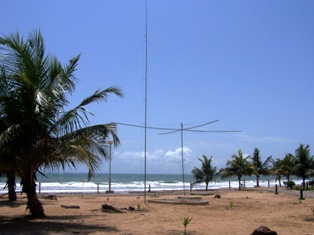
The only item which is still overweight is the linear amplifier. Even using the Acom 1000, which is not one of the heaviest, we could not stay below 28 Kg including the box, which is 5 Kg above the allowed weight. We could use some solid state equipment but, a part that there are few models on the market, they are still rather expensive and we are concerned regarding the reliability, taking in account the risk involved in a dx’expedition, as described hereafter. A tube amplifier like Acom 1000 is robust, rough and not easy to break even in a hard condition. And if something happens, it is often possible to fix it just bringing a small spare part kit and without need of advanced electronic knowledge. Can we say the same having a solid state amplifier and the relevant switching power supply?
The trip to Abokwa was rather long as we left Milan Malpensa airport on Thursday 12 early afternoon to Casablanca with Royal Air Morocco. We had to wait 7 hours there before the final jump to Accra and we took advantage of the long hours to surf the net, thanks to some free wi-fi connections available in the terminal and to call our resort to be sure they would pick us up when we would land at our destination at 03.00. Everything seemed well organized but you never know, Africa is Africa…But in spite of our concerns, the bus drivers were waiting patiently for us in the airport even if it took more than one hour to clear through the customs our 400 kg stuff. A lady officer pretended to keep us waiting till the following day for, in her opinion, the accompanying documents released by the Ghana PT Ministry were not properly stamped and signed. She claimed that it was necessary to get the approval from her boss, who would be in the airport on late morning. It was only after a long negotiation carried on by Stefano and Donato that she agreed to clear our stuff upon a heavy money deposit as a caution. Of course we paid the due even if we were firmly convinced that we would never get our money back. We were nicely surprised when, at our departure, we discovered we were wrong.
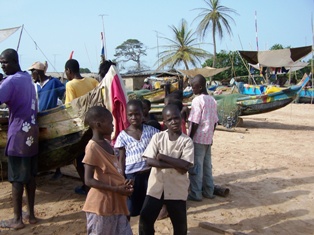
The following day we started to look for a way to get to the island and to rent a generator and the boat to get to the island. We looked for a link to internet as the connection in the hotel business centre was not suitable for our purpose.
We had to bear in mind constantly that we were in Africa and no surprise if, in spite of various contacts and conversations, nobody came in due time and day to an appointment. Only the following day somebody came to us bringing a small generator which refused to start. Another day lost before they came to fix it. It was a really small generator, sufficient to supply just a K3 running 70W, a laptop and a small lamp but the agreed rental price that we achieved after a long negotiation, is enough in Italy to buy a brand new generator. This is Africa…
The same scenario occured when we rented the return sail to the island: as usual a long negotiation with the local fisherman allowed us getting the service at less than 50% of the starting price but for sure an authentic fortune for them.
The first time we landed on the island it was to explore the site. We decided to start the operation in the late afternoon in order to give a chance to the USA station to qso from AF-Ø84.
To get to the island is not so easy; the local fishermen use some long and narrow wooden boats, pushed by a small outboard engine. The ocean waves, always rather high near the beach, may create some problems to get far enough to find some calm water, easily a lot of water may enter into the boat. This was the right occasion to test our waterproof boxes; their price, even rather high, revealed itself to be a good investment as not a drop went inside in spite they were washed and almost submerged in the salt water.
The island is the natural night refuge of a sort of gulls. To remain there till 11.00 p.m. was not easy, as the birds, the true masters of the house, even if not aggressive, wanted to defend their territory bombing guano on our heads. We were rather well protected under a natural vegetable hut but that was not enough against millions of mosquitoes!
The signals were really strong and the pile-up with the USA huge, a sign that the 2 element yagi and the salt water were doing a great job.
We had 750 qso in log at the end of the first day in the island when the boat came to collect us; which was not bad using 70W only!
Considering the difficulty to share the territory with the gulls in the night time and wanting to facilitate the contact with Europe, we decided to go to the island in the early morning. We operated from AF-Ø84 for further 3 days, including a w.e. and finally we had in the log 2520 qso on 14 MHz. We hope many island hunters are happy.
On the main land the activity is round the clock, operating with three stations, located in different buildings, 50 meters or more apart. We dedicated two apartments, one for the phone station and a second one for the CW, each equipped with a 6 band “spiderbeam”, a vertical for 40 and 80m and an inverted L for 160m located near the CW station. A further apartment was dedicated to the digital mode, on 20m only, and as spare time station, equipped with a 7 band vertical and a solid state amplifier. For the low band receiving, we erect a “pennant” for the phone station and a “EWE” for the CW station, together with a “diamond”. Unfortunately, there was not enough room to lay a “beverage”. We linked the three stations together by a wi-fi network, which allowed to synchronize the N1MM log and to chat. It was very helpful to watch how the others stations were working, on which band, at what rate, it allowed us deciding the band change in order to exploit the propagation.
But, once we reached 31,000 qso approx., the synchronization began getting into trouble and an error message started to appear on the screen at any qso entry. We were forced to renounce to synchronize the logs and to merge them before sending the log update to our pilot station. Later, we discovered that the problem was due to a N1MM bug which had a limit up to 31,000 and exceeding that, the error message appeared, even if the entry was recorded. N1MM was so kind to assure the bug would be fixed in the following software release, good to know for the next expedition.
Internet is a fantastic support, when it is available. We agreed the resort would provide us the connection but unfortunately sometimes that was down for a long time, even one day or more. This is the reason why we could not update our log on line constantly.
A further problem was the power supply: we often had power cut and big voltage variation, sometimes too low, being 180V when the national network was connected, jumping up to 250V when the back-up generators were working. It was a real problem as we needed to connect the jumpers to the amplifier in order to protect them when the voltage was too high but, on the other hand, giving a low tube voltage when the supply voltage was too low.
The worst day was Saturday 21st when a dozen of power cuts knocked-out both Acom 1000 amplifiers.
On the first one we had to replace the tube, that probably failed because a thermal shock occurred during a power failure. On the other amplifier the problem was more ambiguous and we had to exchange several mails and phone calls with Acom in Bulgaria to fix it. Even after the replacement of the antenna relay the amplifier was not working properly and a circuital modification was necessary to fix the damage. We wish to thank Acom and in particular Stan, always patient and competent, for the prompt support given us. And we have to thank Silvano’s experience in logistics if the electronic tube and the antenna relay were included in the spare parts set.
Not even the K3 transceivers remained without problems, when a power cut occurred, the rig could not be switched off as per regular procedure and it affected the sophisticated software. Some functions were altered and not all in the same way in the various rigs so that we needed to exchange them from a station to another. Again we were in strict contact with Elecraft in California through Piero W1NA and we have to thank him too for the support.
Back home, it was enough to reload the original software on the K3 to fix all the troubles. In spite of such problems, and our lack of experience (we’ve learnt that you need to keep available at hand a copy of the original software and the relevant download tools), we may confirm the K3 owns a great receiver, which performs its best managing the difficult signal such as those on the low bands, which were really noisy. We got external filters to avoid interference between the stations but we lost a couple of them probably because of some switch failure during the power cut. Nevertheless we were able to operate two and sometime three stations on the same band without filters, which proves that the K3 receiver front end is not affected by strong local signal.
The lack of sunspots affected negatively the propagation on the high bands, we often spotted ourselves on 21, 24 and 28 MHz at the most favourable time but rarely the bands were open.
On the low bands the noise was very high and the bands closed for some hours in the night. Even by using EWE and flag antennas the noise floor could not be reduced enough to exploit the bands properly. We were aware our signal was strong in Europe, USA and Japan but our problem was to receive the weak signals, just using the Diamond antenna we could cut the noise down, mainly on 160m, and we have to be grateful to this antenna for most of the 600 qso on the top band. We could not experience the beverages: even if we had enough stuff to build two of them, unfortunately there was not enough room to lay them in the right directions.
Another thing we have learnt is to avoid planning dx’expedition during the week before the CQWW. Some very well equipped stations are on the air testing the equipment along the days just before the contest and the bands were getting rather crowded. One of the most performing stations was in Sierra Leone, 9L, not so far from us, and it was often managing a huge pile-up which sometime overlapped ours. That it is something not easy for us to understand as we were there just a year ago, during our previous dx’expedition, making 42K qso from there!
Two weeks are long and short at the same time and finally we got to the end of our expedition: we had 39,300 qso in log, which is not bad considering the bad propagation and all the technical problems we had faced.
We had to leave the resort, a real pearl in the black Africa, very nice, quite and clean, very friendly managed. It will be not easy to forget the long and quite beach, on which we could walk barefoot for hours, the friendliness of the resort personnel, not used to have as guest a group of crazy guys for two weeks which lays meters of wires everywhere. And how to forget the food, dozens of lobsters and fish which made our stomachs happy!
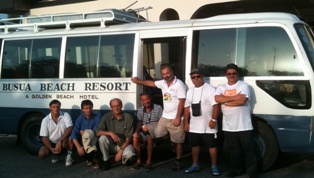 Our bus is ready at 17.00 p.m. to drive us to Accra airport, again a 5-hour trip without aircon, as the system broke after 10 km and given the temperature is constantly above 30 C° even at night, our journey was not comfortable at all.
Our bus is ready at 17.00 p.m. to drive us to Accra airport, again a 5-hour trip without aircon, as the system broke after 10 km and given the temperature is constantly above 30 C° even at night, our journey was not comfortable at all.
Once at the airport we had the nice surprise to get the caution we paid at our arrival back. A bad surprise was waiting for us at the Royal Air Morocco desk as the chief officer charged us for extra weight. In fact the two boxes containing the amplifiers were 28 kg heavy when it is allowed just 23. It was not important for him that the total weight was well below the total allowed as he wanted to consider the weight per each passenger. It may be a simple coincidence but he looked almost identical to the officer in Sierra Leone who charged us for extra weight one year ago….
Special thanks to our pilot station Arturo IK7JWY who patiently updated our log on line and kept us updated with the feedback on our operation through his forum on HAMRADIOWEB.
And finally thanks to all the guys, organization and clubs which have supported our effort.
9G5TT 9G5XX Team
